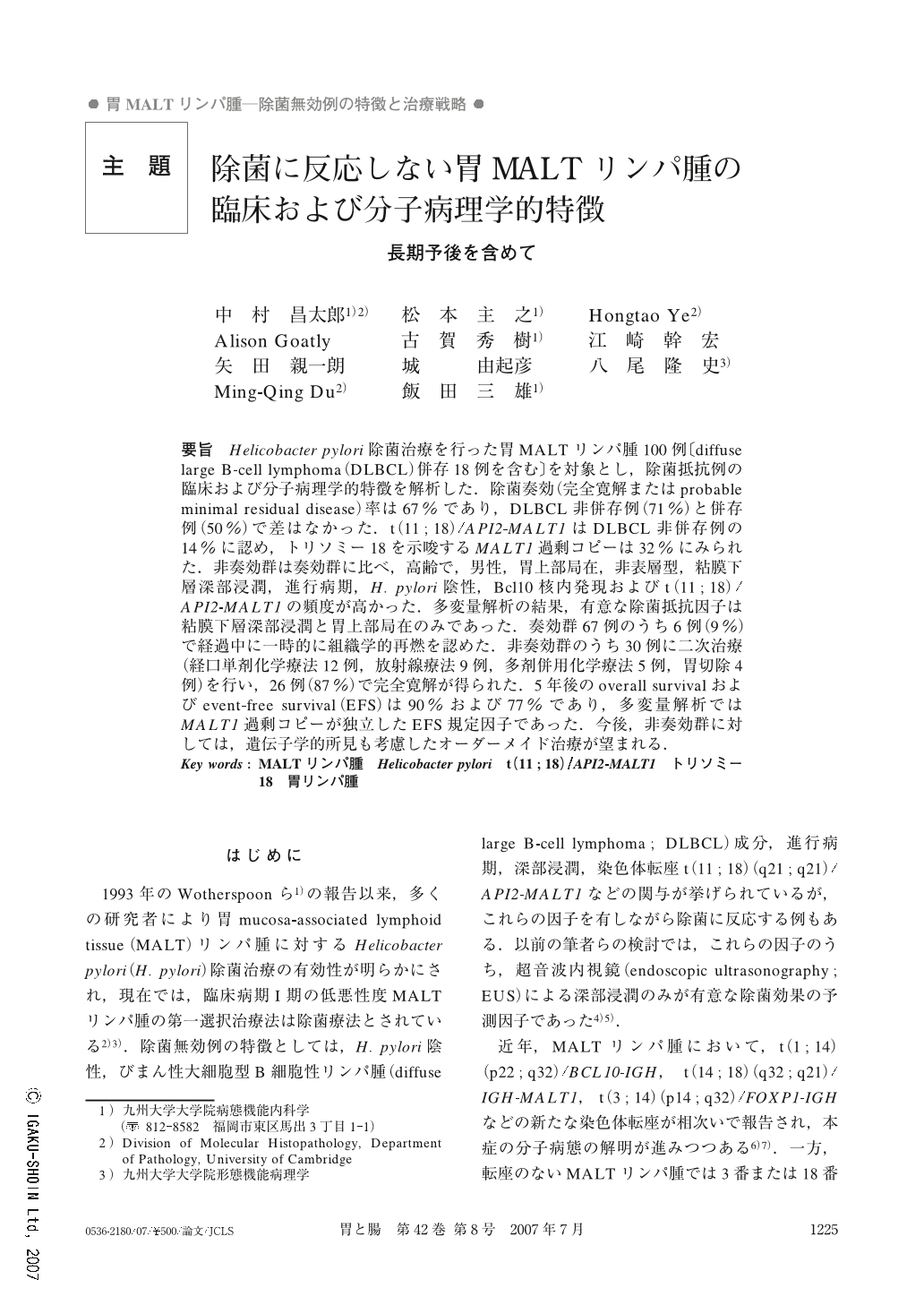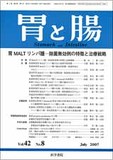Japanese
English
- 有料閲覧
- Abstract 文献概要
- 1ページ目 Look Inside
- 参考文献 Reference
- サイト内被引用 Cited by
要旨 Helicobacter pylori除菌治療を行った胃MALTリンパ腫100例〔diffuse large B-cell lymphoma(DLBCL)併存18例を含む〕を対象とし,除菌抵抗例の臨床および分子病理学的特徴を解析した.除菌奏効(完全寛解またはprobable minimal residual disease)率は67%であり,DLBCL非併存例(71%)と併存例(50%)で差はなかった.t(11;18)/API2-MALT1はDLBCL非併存例の14%に認め,トリソミー18を示唆するMALT1過剰コピーは32%にみられた.非奏効群は奏効群に比べ,高齢で,男性,胃上部局在,非表層型,粘膜下層深部浸潤,進行病期,H. pylori陰性,Bcl10核内発現およびt(11;18)/API2-MALT1の頻度が高かった.多変量解析の結果,有意な除菌抵抗因子は粘膜下層深部浸潤と胃上部局在のみであった.奏効群67例のうち6例(9%)で経過中に一時的に組織学的再燃を認めた.非奏効群のうち30例に二次治療(経口単剤化学療法12例,放射線療法9例,多剤併用化学療法5例,胃切除4例)を行い,26例(87%)で完全寛解が得られた.5年後のoverall survivalおよびevent-free survival(EFS)は90%および77%であり,多変量解析ではMALT1過剰コピーが独立したEFS規定因子であった.今後,非奏効群に対しては,遺伝子学的所見も考慮したオーダーメイド治療が望まれる.
To characterize the gastric MALT lymphomas not responding to Helicobacter pylori (H. pylori) eradication, we retrospectively analyzed the clinicopathological and molecular findings in 100 patients with this disease who underwent H. pylori eradication. Complete remission or probable minimal residual disease was observed in 67 patients (responders) ;the responding rate was not different between cases without diffuse large B-cell lymphoma (DLBCL) (71%) and those with DLBCL (50%). t(11;18)(q21;q21)/API2-MALT1 was detected in 14%of cases without DLBCL, while extra copies of MALT1, suggestive of partial or complete trisomy 18, were found in 32%of all cases. Non-responders were characterized by older age, male patients, location in the proximal stomach, macroscopic appearance without superficial-type, tumors invading the submucosa or deeper, advanced stage, H. pylori negativity, nuclear expression of Bcl10, and t(11;18)(q21;q21)/API2-MALT1. Multivariate analysis revealed that independent predictive factors for non-responders were deep submucosal invasion and location in the proximal stomach. During the follow-up period, temporal histological relapse was observed in 6 of 67 responders (9%). Second-line treatment was performed in 30 patients;oral monochemotherapy in 12 patients, radiotherapy in 9 patients, multi-agent chemotherapy in 5 patients, and gastrectomy in 4 patients. The overall and event-free survival probabilities after 5 years were 90%and 77%, respectively. The presence of extra copies of MALT1 was an independent adverse prognostic factor for event-free survival as determined by multivariate analysis. In future, cytogenetics-based tailored treatment should be considered for patients with gastric MALT lymphoma not responding to H. pylori eradication.

Copyright © 2007, Igaku-Shoin Ltd. All rights reserved.


